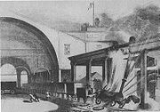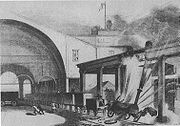
LDE – Comet
Encyclopedia
The German locomotives Comet, Faust, Blitz and Windsbraut were four of the first locomotive
s on the Leipzig-Dresden Railway (LDE). They were four-coupled
engines, that Rothwell and Company had built in Manchester
between 1835 and 1838.
Comet was the first locomotive to be delivered to Saxony
. She arrived at Leipzig
in November 1836, packed in 15 crates. After her reassembly testing began on 28 March 1837 and she was then deployed on railway construction duties. She was followed by Blitz, Windsbraut and Faust, the last named being similar in dimensions to Comet. The other two were somewhat larger (their technical data, where different, are given in the table after a "/")
 All the engines had a cylindrical firebox and boiler barrel, an oak locomotive frame
All the engines had a cylindrical firebox and boiler barrel, an oak locomotive frame
reinforced with sheet iron
and inside cylinders and valve gear
. In 1842, following a serious accident in France the operation of twin-axled locomotives was banned and the engines were given 0-4-2
wheel arrangement through the addition of a trailing axle. Such early machines often had to be repaired at frequent intervals and these engines were no exception. Windsbraut blew up on 21 May 1846 in charge of a train that was ready to depart from the Dresdner station in Leipzig. The other locomotives were retired no later than 1849.
Locomotive
A locomotive is a railway vehicle that provides the motive power for a train. The word originates from the Latin loco – "from a place", ablative of locus, "place" + Medieval Latin motivus, "causing motion", and is a shortened form of the term locomotive engine, first used in the early 19th...
s on the Leipzig-Dresden Railway (LDE). They were four-coupled
Whyte notation
The Whyte notation for classifying steam locomotives by wheel arrangement was devised by Frederick Methvan Whyte and came into use in the early twentieth century encouraged by an editorial in American Engineer and Railroad Journal...
engines, that Rothwell and Company had built in Manchester
Manchester
Manchester is a city and metropolitan borough in Greater Manchester, England. According to the Office for National Statistics, the 2010 mid-year population estimate for Manchester was 498,800. Manchester lies within one of the UK's largest metropolitan areas, the metropolitan county of Greater...
between 1835 and 1838.
Comet was the first locomotive to be delivered to Saxony
Kingdom of Saxony
The Kingdom of Saxony , lasting between 1806 and 1918, was an independent member of a number of historical confederacies in Napoleonic through post-Napoleonic Germany. From 1871 it was part of the German Empire. It became a Free state in the era of Weimar Republic in 1918 after the end of World War...
. She arrived at Leipzig
Leipzig
Leipzig Leipzig has always been a trade city, situated during the time of the Holy Roman Empire at the intersection of the Via Regia and Via Imperii, two important trade routes. At one time, Leipzig was one of the major European centres of learning and culture in fields such as music and publishing...
in November 1836, packed in 15 crates. After her reassembly testing began on 28 March 1837 and she was then deployed on railway construction duties. She was followed by Blitz, Windsbraut and Faust, the last named being similar in dimensions to Comet. The other two were somewhat larger (their technical data, where different, are given in the table after a "/")

Locomotive frame
A locomotive frame is the structure that forms the backbone of the railway locomotive, giving it strength and supporting the superstructure elements such as a cab, boiler or bodywork. The vast majority of locomotives have had a frame structure of some kind...
reinforced with sheet iron
Wrought iron
thumb|The [[Eiffel tower]] is constructed from [[puddle iron]], a form of wrought ironWrought iron is an iron alloy with a very low carbon...
and inside cylinders and valve gear
Valve gear
The valve gear of a steam engine is the mechanism that operates the inlet and exhaust valves to admit steam into the cylinder and allow exhaust steam to escape, respectively, at the correct points in the cycle...
. In 1842, following a serious accident in France the operation of twin-axled locomotives was banned and the engines were given 0-4-2
0-4-2
Under the Whyte notation for the classification of steam locomotives, 0-4-2 represents the wheel arrangement with no leading wheels, four powered and coupled driving wheels on two axles, and two trailing wheels on one axle...
wheel arrangement through the addition of a trailing axle. Such early machines often had to be repaired at frequent intervals and these engines were no exception. Windsbraut blew up on 21 May 1846 in charge of a train that was ready to depart from the Dresdner station in Leipzig. The other locomotives were retired no later than 1849.
See also
- Royal Saxon State RailwaysRoyal Saxon State RailwaysThe Royal Saxon State Railways were the state-owned railways operating in the Kingdom of Saxony from 1869 to 1918...
- List of Saxon locomotives and railbuses
- Leipzig-Dresden Railway
External links
- There is a relevant English-language forum at Railways of Germany

